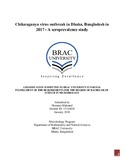Chikungunya virus outbreak in Dhaka, Bangladesh in 2017 - a seroprevalence study

View/Open
Date
2018-01Publisher
BRAC UniveristyAuthor
Mahmud, HumairaMetadata
Show full item recordAbstract
Chikungunya is a viral disease transmitted by mainly Aedes aegypti and Aedes albopictus mosquitoes. In 2017, Chikungunya virus was introduced into the Dhaka city of Bangladesh and triggered a massive outbreak which affected millions of lives and forced upon significant damages in socioeconomic factors. Since the disease appeared quite recently in this region and this is the first time such a widespread transmission occurred, there is a lack of adequate data to assess the viral burden in the population and the effectiveness of laboratory procedures that can be implemented in resource limited countries like Bangladesh. Hence, this study was conducted to evaluate the rapid techniques available for the serological diagnosis of Chikungunya. For this research, a population based cross-sectional study was carried out to correlate the clinical cases with laboratory confirmation by two main serological techniques called ICT and ELISA. Immunochromatographic (ICT) test was performed on a total of 1201 collected convalescent blood samples and among them Enzyme linked immunosorbent assay was performed on a total of 81 individuals who were selected through proper sampling technique for the detection of IgM or IgG antibodies against CHIKV which confirms the infection. The sensitivity and specificity of the ICT test was determined as 83% and 100% respectively by taking ELISA as the reference method. The seroprevalence of the convalescent samples drawn by the rapid test is 75.2%. Gender distribution of Convalescent seropositive Chikungunya cases showed a higher infection rate in male than female with seroprevalence rates of 79.7% and 68.5% respectively. The data of age distribution revealed that seroprevalence rate is much higher in older people than younger people. In addition, statistical analyses confirmed the association of age and gender with seropositivity determining them as possible risk factors. Furthermore, it was detected that fever, joint pain and rash were significantly related with CHIKV seropositivity. Overall, considering all these findings Chikungunya infection must be given considerable weight and proper diagnostic procedure and management strategies should be taken to control the situation.
